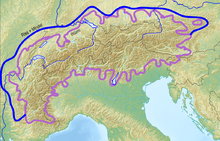
Back Laat Pleistoseen Afrikaans البليستوسيني المتأخر Arabic Plistocè superior Catalan Jungpleistozän German Tarantiense Spanish Tarantiar Basque پلیستوسن پسین Persian Pléistocène supérieur French Jongpleistozän FRR Plistoceno superior Galician
| Late/Upper Pleistocene | |||||||||
|---|---|---|---|---|---|---|---|---|---|
| Chronology | |||||||||
| |||||||||
| Etymology | |||||||||
| Name formality | Informal | ||||||||
| Proposed name(s) | Tarantian | ||||||||
| Usage information | |||||||||
| Celestial body | Earth | ||||||||
| Regional usage | Global (ICS) | ||||||||
| Time scale(s) used | ICS Time Scale | ||||||||
| Definition | |||||||||
| Chronological unit | Age | ||||||||
| Stratigraphic unit | Stage | ||||||||
| Time span formality | Formal | ||||||||
| Lower boundary definition | Not formally defined | ||||||||
| Lower boundary definition candidates | Marine Isotope Substage 5e | ||||||||
| Lower boundary GSSP candidate section(s) | None | ||||||||
| Upper boundary definition | End of the Younger Dryas stadial | ||||||||
| Upper boundary GSSP | NGRIP2 ice core, Greenland 75°06′00″N 42°19′12″W / 75.1000°N 42.3200°W | ||||||||
| Upper GSSP ratified | 14 June 2018 (as base of Greenlandian)[3][4] | ||||||||
| Millennia: | |
|---|---|
| Centuries: |
|

The Late Pleistocene is an unofficial age in the international geologic timescale in chronostratigraphy, also known as the Upper Pleistocene from a stratigraphic perspective. It is intended to be the fourth division of the Pleistocene Epoch within the ongoing Quaternary Period. It is currently defined as the time between c. 129,000 and c. 11,700 years ago. The late Pleistocene equates to the proposed Tarantian Age of the geologic time scale, preceded by the officially ratified Chibanian (commonly known as the Middle Pleistocene).[1] The beginning of the Late Pleistocene is the transition between the end of the Penultimate Glacial Period and the beginning of the Last Interglacial around 130,000 years ago (corresponding with the beginning of Marine Isotope Stage 5).[5] The Late Pleistocene ends with the termination of the Younger Dryas, some 11,700 years ago when the Holocene Epoch began.[2]
The term Upper Pleistocene is currently in use as a provisional or "quasi-formal" designation by the International Union of Geological Sciences (IUGS). Although the three oldest ages of the Pleistocene (the Gelasian, the Calabrian and the Chibanian) have been officially defined, the late Pleistocene has yet to be formally defined.[6]
Following the brief Last Interglacial warm period (~130-115,000 years ago), where temperatures were comparable to or warmer than the Holocene, the Late Pleistocene was dominated by the cool Last Glacial Period, with temperatures graduate lowering throughout the period, reaching their lowest during the Last Glacial Maximum around 26-20,000 years ago.
Most of the world's large (megafaunal) animals became extinct during the Late Pleistocene as part of the Late Pleistocene extinctions, a trend that continued into the Holocene. In palaeoanthropology, the late Pleistocene contains the Upper Palaeolithic stage of human development, including the early human migrations of modern humans outside of Africa, and the extinction of all archaic human species.
- ^ a b Cohen, K. M.; Finney, S. C.; Gibbard, P. L.; Fan, J.-X. (January 2020). "International Chronostratigraphic Chart" (PDF). International Commission on Stratigraphy. Retrieved 23 February 2020.
- ^ a b Mike Walker; et al. (December 2018). "Formal ratification of the subdivision of the Holocene Series/Epoch (Quaternary System/Period)" (PDF). Episodes. 41 (4). Subcommission on Quaternary Stratigraphy (SQS): 213–223. doi:10.18814/epiiugs/2018/018016. Retrieved 11 November 2019.
- ^ Walker, Mike; Head, Martin J.; Berkelhammer, Max; Björck, Svante; Cheng, Hai; Cwynar, Les; Fisher, David; Gkinis, Vasilios; Long, Anthony; Lowe, John; Newnham, Rewi; Rasmussen, Sune Olander; Weiss, Harvey (1 December 2018). "Formal ratification of the subdivision of the Holocene Series/ Epoch (Quaternary System/Period): two new Global Boundary Stratotype Sections and Points (GSSPs) and three new stages/subseries" (PDF). Episodes. 41 (4): 213–223. doi:10.18814/epiiugs/2018/018016. Retrieved 28 August 2020.
- ^ Head, Martin J. (17 May 2019). "Formal subdivision of the Quaternary System/Period: Present status and future directions". Quaternary International. 500: 32–51. Bibcode:2019QuInt.500...32H. doi:10.1016/j.quaint.2019.05.018. S2CID 182783922.
- ^ D. Dahl-Jensen & others (2013). "Eemian interglacial reconstructed from a Greenland folded ice core" (PDF). Nature. 493 (7433): 489–494. Bibcode:2013Natur.493..489N. doi:10.1038/nature11789. PMID 23344358. S2CID 4420908.
- ^ P. L. Gibbard (2015). "The Quaternary System/Period and its major subdivisions". Russian Geology and Geophysics. 56 (4): 686–688. Bibcode:2015RuGG...56..686G. doi:10.1016/j.rgg.2015.03.015.
© MMXXIII Rich X Search. We shall prevail. All rights reserved. Rich X Search